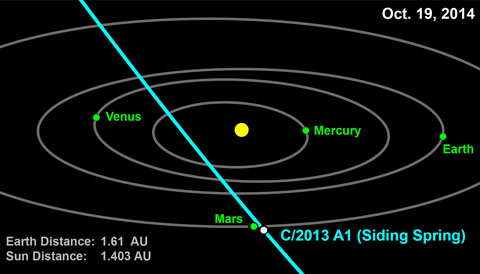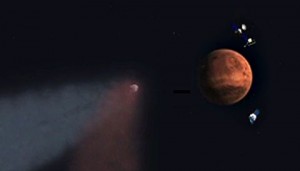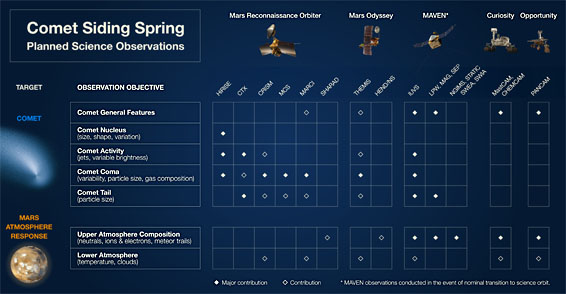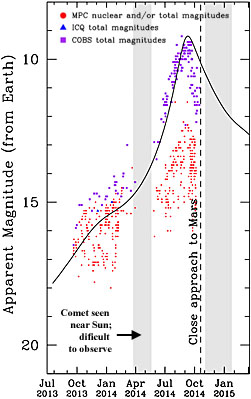Mars has a front-row seat for an extremely close encounter with Comet Siding Spring (C/2013 A1) on October 19th.

NASA / JPL / Horizons
History is being made this week: a comet is about to pass closer to a planet (without hitting it) than ever before in recorded human history.
Unfortunately, the planet is not Earth — it's Mars.
On October 19th, at 18:29 Universal Time, Comet Siding Spring (C/2013 A1) is going to pass about 85,000 miles (137,000 km) from the Red Planet — about a third of the Earth-Moon distance. As seen from the Martian surface, the comet will be a huge glowing cloud in the nighttime sky with an estimated total magnitude of about –6.
The dust tail left in C/2013 A1’s wake will miss Mars, but not by much. Still, multiple teams of dynamicists suspect that a few percent of the particles, those with the highest ejection velocities, could strike the planet about 90 to 100 minutes after the nucleus comes closest.
Since those comet crumbs will be arriving at a very fast 35 miles (56 km) per second, even the smallest of them could inflict damage on one or more of the five spacecraft now in orbit around Mars. To avoid this threat, over the past few months NASA engineers have manipulated the trajectories of the agency's spacecraft (Mars Reconnaissance Orbiter, Mars Odyssey, and the just-arrived MAVEN) so that these craft will all be on the opposite side of the planet during the window of greatest danger.
| Back here on planet Earth, Mars is still observable low in the southwest after sunset. But the comet is so faint (no brighter than 11th or 12th magnitude) that you'll need a sizable telescope to view it. Fortunately, Italian observer Gianluca Masi has just that. Join his Virtual Telescope Project for online viewing of the comet encounter beginning at 16:45 Universal Time, or 12:45 p.m. EDT, on the 19th. |
A Deep-Space Visitor
Despite this duck-for-cover caution, planetary scientists are looking forward to the encounter with excitement. This comet is special because it's a first-time visitor to the inner solar system. Its icy nucleus, on the smallish side with an estimated diameter of roughly a half mile (700 meters), has been inbound from the distant Oort Cloud for the past several million years. Never before has it felt the Sun's warmth.

NASA / ESA / J.-Y. Li (Planetary Science Inst.)
When first spotted it on January 3, 2013, it was still very far from the Sun: 7.2 astronomical units (a.u.), or 670,000,000 miles. Credit for the discovery goes to veteran comet-hunter Rob McNaught, who captured it as a 18½-magnitude blip in a series of images taken with the Uppsala Southern Schmidt Telescope at Siding Spring Observatory in Australia. (Tragically, 10 days later a wildfire overran part of the observatory, destroying McNaught's home.)
Most comets don't "turn on" until they get much closer in. But by then the nucleus of C/2013 A1 had already started releasing gas and dust to form a coma. Last June, having cruised to within 2½ a.u. of the Sun, the comet became much more active. By then visible-light images from the Hubble Space Telescope showed multiple jets coming off the nucleus, and infrared views from the Spitzer Space Telescope showed that most of the gas was carbon dioxide.

NASA / JPL
Hubble and Spitzer are just two components of a 16-pronged attack that NASA scientists will be using to record the historic encounter.
The most anticipated of these observations will come from the three NASA orbiters (and its rovers Curiosity and Opportunity) with front-row seats. "Normally you would send a spacecraft to the comet," noted NASA planetary scientist Kelly Fast during a briefing last week. "In this case the comet is coming to the spacecraft."

NASA / CIOC
Also on the scene are the European orbiter Mars Express and India's Mars Orbiter Mission (MOM). Although these two will not be protected by the planet, the Mars Express flight team plans to shut down nonessential systems and turn the craft so its big dish antenna can serve as a dust shield.

CIOC
Comet Siding Spring passes through its orbit's perihelion just 5 days after zipping past Mars, so activity should be very high. However, observers noted a fall-off in the comet's brightness earlier this month. There might be several explanations for this, but for now scientists are doing more watching than speculating.
One key observation will come from MRO's HiRISE camera, whose images should be able to resolve the comet's nucleus (though it'll appear just a few pixels across)."This one is really difficult," cautions Alfred McEwen (University of Arizona), who heads the HiRISE team, "but we'll have a good story to tell if it succeeds."
Meanwhile, since dynamicists expect the comet's extended gas-and-dust coma to envelop the planet briefly, MAVEN and MOM will both be watching for changes in the composition and temperature of the planet's upper atmosphere. Spotting a burst of meteors isn't out of the question.
More information about this unprecedented encounter is here. Be sure to check out this dramatic NASA animation (but ignore the over-the-top soundtrack).
Our special issue, "Mars: Mysteries & Marvels of the Red Planet," is loaded with spectacular photos and a must-read for anyone interested in this intriguing neighboring world.
 1
1
Comments
Aqua4U
October 20, 2014 at 4:35 pm
I'm on the edge of my front row seat. Thanks!
You must be logged in to post a comment.
You must be logged in to post a comment.